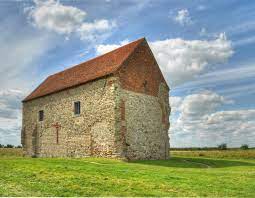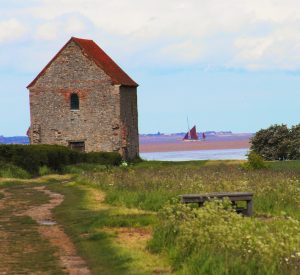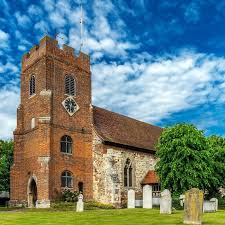
Here are some very interesting medieval churches that we have come across whilst sweeping for sweeping for the Diocese of Chelmsford. They are quite a long way from home that’s for sure! These are from a visit we made to sweep the Rectory at Bradwell-on-Sea. There are two medieval churches in Bradwell-on-Sea, the parish church of St Thomas’s and St Peter’s-on-the-Wall. The rectory lies down the lane from St Thomas’s and towards St Peter’s-on-the-Wall, which is down a long track towards the sea.
St Peter’s-on-the-Wall is a real gem of a church in the most atmospheric and enigmatic of locations. It is a grade 1 listed building and is believed to be among the oldest largely intact Christian churches in England; it is still in regular use. It dates from the years 660–662. The chapel is used regularly by the nearby Othona Community, in addition to Church of England services.
According to Bede (who wrote his history in the early 8th century), a ‘city’ named Ythanceaster existed on the River Penta. The Chapel of St Peter-on-the-Wall was almost certainly originally built by Bishop Cedd in 654. It was an Anglo-Celtic church for the East Saxons, set astride the ruins of the abandoned Roman fort of Othona. The current structure was most likely built around 654–662, incorporating the Roman bricks and stones. In 653 Cedd travelled south from Lindisfarne to spread Christianity at the behest of Sigeberht the Good, then King of the East Saxons, and, having been ordained as a bishop, returned the next year in order to build the Chapel, and probably others too. Following the death of Cedd in October 664 from plague, the Chapel became part of the Diocese of London.
No further record exists of the Chapel being used until 1442, when the local clergy reported to the Bishop of London that it had been expanded slightly, with a small tower above the porch with a bell in it. However, they did not know of its origins, and it was unusable, having been burnt. It was repaired and returned to regular use alongside the parish church in Bradwell-on-Sea until at least the Tudor period (16th century) before falling into disuse as a church again and being used as a barn—the position of the wide barn doorway, now filled in, can be seen on the south side of the nave. In 1920 it was restored and reconsecrated as a chapel; it achieved Grade I listed status in 1959.
St Peter’s-on-the-Wall is sited on the western entry gate way of the Roman Saxon Shore Fort of Orthona. Othona or Othonae was one of a chain of Saxon Shore forts located all around the coast of southeast Britain. The Old English name Ythanceaster for the locality derives from the Roman name.

The fort of Othona is in a typical late 3rd century style, and was possibly constructed during or shortly prior to the Carausian Revolt, making it contemporary with the forts at Dubris, Portus Lemanis and Gariannonum. According to the early 5th-century Notitia Dignitatum, which is the only contemporary document mentioning Othona, the fort was garrisoned by a numerus fortensium (“numerus of the brave ones”). Othona’s location at the edge of the Dengie Peninsula was ideal for control of the estuaries of the rivers Blackwater and Colne, the latter leading to the important city of Camulodunum (now Colchester). The fort’s shape was roughly trapezoidal, with rounded corners. The stone rampart was 4.2 metres thick, indicating a tall superstructure, and enclosed over 2 hectares (4.9 acres). A single exterior ditch surrounded the site. Although some of the Roman building material was reused in the 7th century Chapel of St Peter-on-the-Wall, enough of the rampart survived until the 17th century, when it was described by the local historian Philemon Holland as a “huge ruin”. It has since been largely swallowed by the sea, leaving scant remains on view.
The Saxon Shore (Latin: litus Saxonicum) was a military command of the late Roman Empire, consisting of a series of fortifications on both sides of the English Channel. It was established in the late 3rd century and was led by the “Count of the Saxon Shore“. In the late 4th century, his functions were limited to Britain, while the fortifications in Gaul were established as separate commands. Several Saxon Shore forts survive in east and south-east England.
During the latter half of the 3rd century, the Roman Empire faced a grave crisis. Internally, it was weakened by civil wars, the violent succession of brief emperors, and secession in the provinces, while externally it faced a new wave of attacks by barbarian tribes. Most of Britain had been part of the empire since the mid-1st century. It was protected from raids in the north by the Hadrianic and Antonine Walls, while a fleet of some size was also available.
However, as the frontiers came under increasing external pressure, fortifications were built throughout the Empire in order to protect cities and guard strategically important locations. It is in this context that the forts of the Saxon Shore were constructed. Already in the 230s, under Severus Alexander, several units had been withdrawn from the northern frontier and garrisoned at locations in the south, and had built new forts at Brancaster and Caister-on-Sea in Norfolk and Reculver in Kent. Dover was already fortified in the early 2nd century, and the other forts in this group were constructed in the period between the 270s and 290s.

St Thomas is also a very interesting medieval church and is itself grade 2 listed. The chancel and south porch are 14th Century work, however the nave was rebuilt in 1706 and the west tower was added at that time.Further changes took place in the Victorian period with the north organ chamber being added and some restoration work being completed by Chancellor in 1864. There is a pleasing contrast in the different building materials used and blending of different architectural styles. The chancel and organ chamber are constructed from flint rubble and septaria, whilst the nave is built from brick and stone and the tower is exclusively made from brick with Limestone dressings. The plain red peg tile roof is also a very pleasing feature. The west doorway has some interesting dog tooth molding above it. There are also a number of fascinating wall brasses on the north wall, (1) Margaret Wyott 1526, woman in a pedimental head-dress. (2) early C16 shield of arms, 3 owls and a sinister quarter impaling 4 bars on a bend of 3 scallops. (3) Thos. Debanke 1606 – inscription. (4) Johannes Debanke 1601. The church is well worth a visit, particularly if you are considering visiting the atmospheric church of St Peter’s-on-the-Wall – So much history and beautiful architecture, what’s not to like!


 My name is Paddy McKeown, I am a retired police officer (Detective Sergeant – Metropolitan Police), turned chimney sweep. I have completed training with ‘The Guild of Master Chimney Sweeps’, and Rod Tech UK (Power Sweeping).
My name is Paddy McKeown, I am a retired police officer (Detective Sergeant – Metropolitan Police), turned chimney sweep. I have completed training with ‘The Guild of Master Chimney Sweeps’, and Rod Tech UK (Power Sweeping).




Comments are closed.